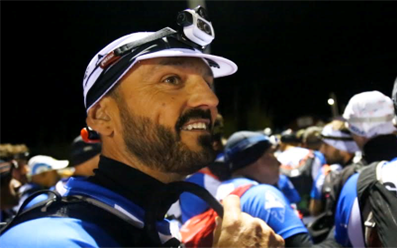
Fabrice at the start of La Trail du Bourbon race. (Photo provided by Fabrice Huré.)
What would you do if one day you were diagnosed with a chronic illness that took over your life and kept you away from the outdoor adventures that you loved so much?
That’s just the question that Fabrice Huré faced when he started hemodialysis after an incidental diagnosis of Alport Syndrome prior to a knee operation in 1996 at the age of 20. After a failed transplant several years later had condemned him back to regular dialysis, Fabrice began to lose hope that he would ever live a normal life again. Over the next five years, the thrice weekly four-hour dialysis sessions took over all of his free time and much of his physical and mental energy. Realizing he needed a change, and with the help of new modalities like long nocturnal dialysis (LND) freeing up a lot of his time, Fabrice began to find ways to return back to the mountain sports he loved. An accomplished mountain athlete and trail runner, Fabrice has competed in several major ultramarathons such as La Trail du Bourbon (112km in 50 hours), as highlighted in the documentary film “The Mountain in His Blood”. In his full-time job, he works in computer design and development for several fitness and wellness startups. He has also become a major advocate for patients with chronic kidney disease (CKD) and accessibility to modalities such as LND. His slogan has become, “Dialysis at night to relive the day!”
Below, Associate Wilderness Medicine Magazine Editor, Marc Cassone interviews Fabrice on his experiences as a mountain athlete.
Marc Cassone (MC): Fabrice, your story is a true source of inspiration, especially for people with CKD and those undergoing dialysis. Your dedication to an active outdoor lifestyle is impressive, but what pushed you to pursue more challenging exploits like ultramarathons, multiday races, and backcountry skiing?
Fabrice Huré (FH): Firstly, I don’t like using words like “exploit” or “challenge”. I would just say that I try to live adventures and see new horizons that are different than my daily life as a person with a chronic illness. These moments that I share with my loved ones have a positive impact on my mental health and are a source of internal resilience. Exploring wide-open spaces gives me much hope for the future and the symbolism of being in immense mountain landscapes increases my energy exponentially for my day-to-day life.
MC: I really enjoyed the film, “Plus Belle la Nuit”, that tells the story of your 2020 trek across the famous GR20 in Corsica over six days and two dialysis treatments. The night where you lost electricity and almost weren’t able to complete your dialysis was nerve-wracking! What were the biggest obstacles of the trek that maybe weren’t shown in the film?
FH: The biggest challenges were the logistics, which took my friend, Niko, and I several months to plan out. After the COVID-19 quarantines, we just needed to meet up and plan a great trip together. We were nineteen runners traversing the GR20 with an additional six people as our logistical support. Niko put together the stages so there would be a refuge or other accommodation with electricity whenever I planned to need my dialysis sessions. That’s how we ended up with a pretty unique itinerary and doing the trail in reverse (south to north). On my end, I reserved all the lodging and meals to limit the uncertainties.
What was crazy was that the lodging I was at when the power went out, in the village of Ghisoni, was only 30 minutes away from the refuge all my friends were staying in that night! We had correctly suspected that the generator at the refuge wouldn’t hold the charge, but it turns out the whole village lost power at midnight - the blackout lasted for five hours. My wife and I decided to go to sleep and announce to everyone in the morning that I would have to stop the adventure to be able to complete my dialysis.
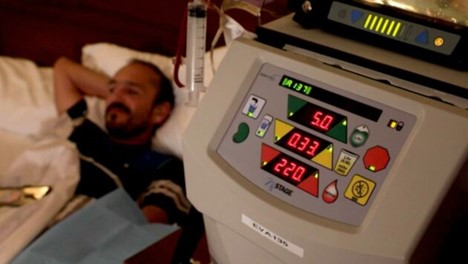
Fabrice undergoing one of the dialysis treatments completed during his multiday trek across Corsica’s famed GR20. (Photo provided by Fabrice Huré.)
That morning, after we met up with the rest of the group and announced the bad news, Niko was having none of it - he had come up with a genius idea: I would head back to the village, complete another three hours of dialysis, and then meet up with the rest of the group on a pass about halfway down that day’s trail. After discussing the plan with my nephrologist, I went back to the village and completed three hours of dialysis with some of the extra supplies I had brought and the remaining dialysate from the night before. By 1pm, my wife had dropped me off at the pass to meet the group and continue the adventure!
I have to admit, my wife was more than just part of the group’s support crew since she had to set up and transport all my equipment for each stage as well. This was the first time I had asked her to help so much with my treatments and she rose to the occasion, especially since she didn’t get to have the grand adventure or see all the beautiful scenery that I did. This adventure would not have been possible without her hard work and generosity. In the end, the adventure made me realize that integrating regular sessions of at-home dialysis into a trip like this definitely took a lot of mental and physical energy.
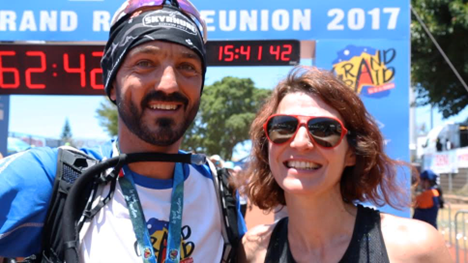
Fabrice and his wife, Christine, at the start of La Trail du Bourbon, l’Ile de la Réunion. (Photo provided by Fabrice Huré.)
MC: I saw that you recently transported a mobile dialysis unit to the Refuge du Portillon in the French Pyrenees (altitude 2571m) for a nocturnal treatment. What were the logistics behind this trip and what is the future potential of mobile dialysis units?
FH: For this next adventure, I wanted to be more autonomous than on the GR20 trip. The biggest logistical hurdle was to find the highest refuge in the Pyrenees with 24h electricity to be able to handle my regular weekly schedule: three nocturnal eight-hour dialysis sessions.
Other logistical issues included transporting all the equipment in my trailer to the Pyrenees from my home in Rennes, planning my at-home dialysis treatments before and after the trek (I stayed with friends in Toulouse), and, most notably, hiking up all the equipment with help from friends. In total, the mobile unit weighed 100kg: 40L of dialysate, the 45kg dialysis unit with carrying case, plus all the extra material (scale, BP cuff, and other medical and safety equipment). We were able to borrow a joëlette [one-wheeled trekking chair] that we adapted with some planks to help transport the equipment. Unfortunately, the joëlette got a flat tire about a third of the way up and since we didn’t think to bring a spare tire or pump, we had to redistribute the equipment into everyone’s packs. I think this adventure showed us the potential of these “mobile” units, however, we were still constrained by the overall weight, not to mention all the medical wastes from an ecological perspective.
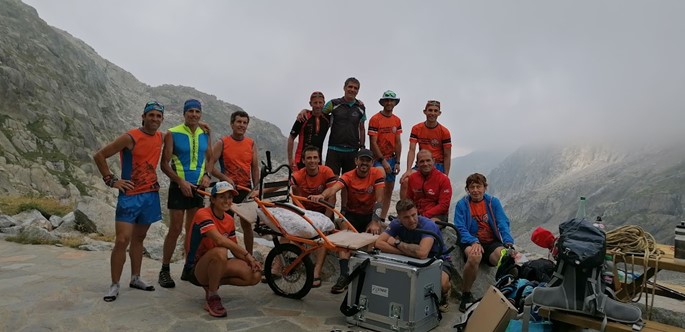
Fabrice, his team, and the mobile dialysis unit they trekked to the Refuge du Portillon in the French Pyrenees. (Photo provided by Fabrice Huré.)
MC: From a medical perspective, I’m sure there were challenges beyond just setting up your dialysis machines. How did you manage elements such as diet, hydration, volume status, electrolytes, etc.?
FH: I didn’t really rigorously plan out these elements for any of the specific events. I would say that it was my 20 years of practicing sports while on dialysis that allowed me to understand my capabilities, my limits, and managing my overall health when I’m out on an adventure. Long nocturnal dialysis (LND) is the start of a chain reaction that leads to an improvement in quality of life. Observational studies have associated it with reduced left ventricular hypertrophy, increased erythropoietin levels, better phosphate control, improving hypertension, and decreasing rates of hospitalization. In a general sense, LND appears to improve appetite, sleep, energy levels, quality of life, and overall survival. The bigger challenge was to be able to leave for an adventure in my peak physical shape after lots of endurance training. Diet planning has to be strict, especially in terms of potassium to avoid cardiac arrythmias (so avoiding bananas, dry fruits, etc.).
MC: There is limited data on how patients with CKD and on dialysis fare at high altitudes. What have been your experiences living and recreating at high elevations?
FH: I am not very familiar with the scientific data myself, but I can say that I do have an appetite for mountains and high-altitude environments - even if it means being more vigilant. Last summer was the first time I went to 3000m and we did it gradually in stages knowing that it wouldn’t be an exact science in my case. We need to have humility - whether it be in the mountains or on the sea - weighed out in terms of what we can do to limit risks: endurance training before a trip, keeping an eye on the weather, bringing extra layers even when the weather appears nice, etc..
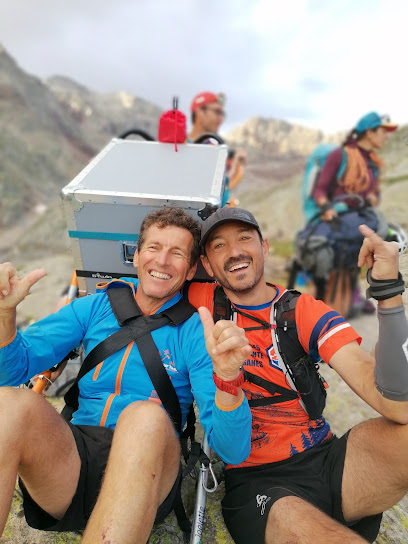
Fabrice and a friend use his mobile dialysis unit as an impromptu backrest during one of his recent adventures. (Photo provided by Fabrice Huré.)
MC: What do you see as the future for people on dialysis, in terms of outdoor sports and adventures? What are your future plans?
FH: Ultimately, the best future for patients with CKD is a genetically compatible kidney transplant with little need for immunosuppressant therapy. Regardless of dialysis, I think the biggest priority for a big adventure is being able to do all the preparation required for the goal you set. However, modalities like LND allows you to free up your schedule and gives you the time it takes to do all the training and preparation required for a big trip. I truly think my biggest achievement has been to balance working a full-time job, training 3-4 times a week, and completing my dialysis sessions for the past 26 years. Honestly, without LND I don’t think I would have been able to do a tenth of the adventures I’ve accomplished.
This year, I’m hoping to compete in L’Echappée Belle (an 84km trail race in the French Alps) and in 2024, my team and I are hoping to complete the mythic La Diagonale des Fous (170km) on l’Ile de la Réunion - as special place for me, where I first realized that despite dialysis, life goes on !
MC: Thanks so much for your responses. Looking forward to hearing about these next big trips and thanks for being an inspiration!
Responses translated from originals in French by Marc Cassone, with permission and final approval by Fabrice.